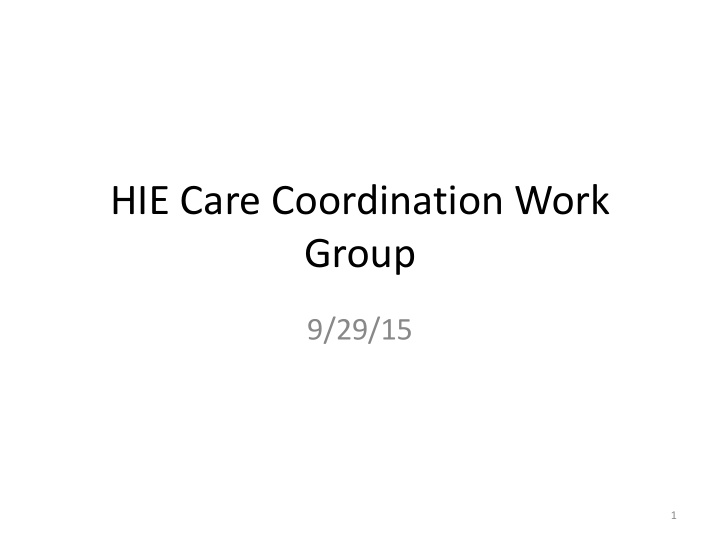



HIE Care Coordination Work Group 9/29/15 1
Care Coordination Definition Care Coordination involves deliberately organizing patient care activities and sharing information among all of the participants concerned with a patient's care to achieve safer, more effective care and improve health outcomes. The main goal of care coordination is to meet the individual’s patients’ needs and preferences in the delivery of high quality, high value health care. This means that an individual’s needs and preferences are known and communicated at the right time to the right people, and that this information is used to guide the delivery of safe, appropriate, and effective care. Further, the scope and intensity of care coordination services provided is based upon the individual’s assessed needs and preferences. 2
Components of Care Coordination • A Health Care Home establishing accountability and responsibility that works to align resources with patient and population needs • Interdisciplinary teamwork • Comprehensive care management that includes: – Assessment of individual needs and goals – Creating a proactive care plan – Monitoring and follow up including responding to changes in individuals’ needs – Supporting individuals’ self -management goals – Effective management of transitions of care – Linking to community resources – Medication Management – Health Promotion and Wellness • Health Information Technology and Exchange 3
Today’s SIM Road Map SIM Overall Goals: Improve health outcomes, experience of care, and value in health care spending for high-cost, high- need patients in D.C. SIM Short Term Goal : Implement a Chronic Condition Health Home SIM Long Term Goal : Transform the payment/delivery system to hold providers accountable for outcomes 4
Chronic Condition Management Initiatives Medicaid Health Home Medicare Chronic Care Management (CCM) • Program Summary: Pays providers to integrate and • Program Summary: Pays physicians ~$40 PMPM coordinate primary, acute, behavioral health, and long- for care management (outside of face-to-face visits) term services and supports to treat the whole person that includes at least 20 minutes of clinical staff time • Patient Eligibility: • Patient Eligibility: • Have 2 or more chronic conditions • Patients with 2 or more chronic conditions lasting at least a year • Have 1 chronic condition and are at-risk for a 2 nd • Have 1 serious & persistent mental health condition • Mandatory Services: • 24/7 care management services • Mandatory Services: • Continuity of care via a designated practitioner • Comprehensive care management • Care transition management • Care coordination • Creation of an electronic patient-centered care plan • Comprehensive transitional care/follow-up • Enhanced chances to communicate with provider • Health promotion • Home and community-based services coordination • Patient & family support • EHR utilization for structured recording of clinical data • Referral to community & social support services • Eligible Providers: • Eligible Providers: • Physicians and non-physician practitioners (Certified • Designated provider (e.g. physician, group practice, Nurse Midwives; Clinical Nurse Specialists; NPs; and clinic) PAs) may bill the CCM code • Team of health professionals (e.g. physicians, nurse • Clinical staff can provide the CCM service incident to care coordinators, nutritionists, social workers) the services of the billing physician under general • Health team (e.g. specialists, nurses, pharmacists, supervision of a physician nutritionists, dieticians, social workers) 5
Chronic Condition Prevalence in DC’s Medicaid Population 1 5 or More Chronic Conditions 2-4 Chronic Conditions • 64,274 Beneficiaries • 18,148 Beneficiaries • FFS : • FFS : • Total: 31,270 • Total: 13,668 Beneficiaries • Age 0-5: 187 • Age 0-5: 9 Beneficiaries • Age 0-20: 2,102 • Age 0-20: 158 Beneficiaries • Age 65+: 10,242 • Age 65+: 4,777 Benes. • MCO : • MCO : • Total: 33,004 • Total: 4,480 Beneficiaries • Age 0-5: 1,015 • Age 0-5: 14 Beneficiaries • Age 0-20: 5,464 • Age 0-20: 140 Beneficiaries • Age 65+: 110 • Age 65+: 19 Beneficiaries 1. Based on 37 chronic condition categories, grouped by the Hwang chronic condition indicator file, see: https://www.hcup-us.ahrq.gov/toolssoftware/chronic/chronic.jsp 6
Spending Impact (FY14) • Average Per Person Spending: $10,050 • FFS: $27,378 (based on 58,034 beneficiaries with a claim in FY14) • MCO: $4,014 (based on 166,586 beneficiaries with a claim in FY14) Total • ED Visits: 70,649 MCO beneficiaries had an ED visit (42% of MCO as compared to 23% Medicaid of FFS) Population • IP Visits : 12,987 FFS beneficiaries had an IP visit (22% of FFS as compared to 9% of MCO) • Long-Term Care: Comprises 32% ($757,026,295) of total Medicaid expenditures • Proportion of Spending (FFS and MCO): • Top 1 percentile: 2,339 beneficiaries make up 27% of total Medicaid spending • Top 5 percentile: 13,855 beneficiaries make up 60% of total Medicaid spending • Average Per Person Spending within Top 1 Percentile: High Cost • FFS: $495,861 Beneficiaries • MCO: $206,125 • Top 10 Chronic Conditions within Top 1 Percentile: 1) Hypertension; 2) Behavior Problems; 3) Diabetes; 4) Dementia; 5) Paralysis; 6) Cerebrovascular Disease; 7) Chronic Renal Failure; 8) CHF; 9) Hyperlipidima; and 10) Depression 7
Recommend
More recommend